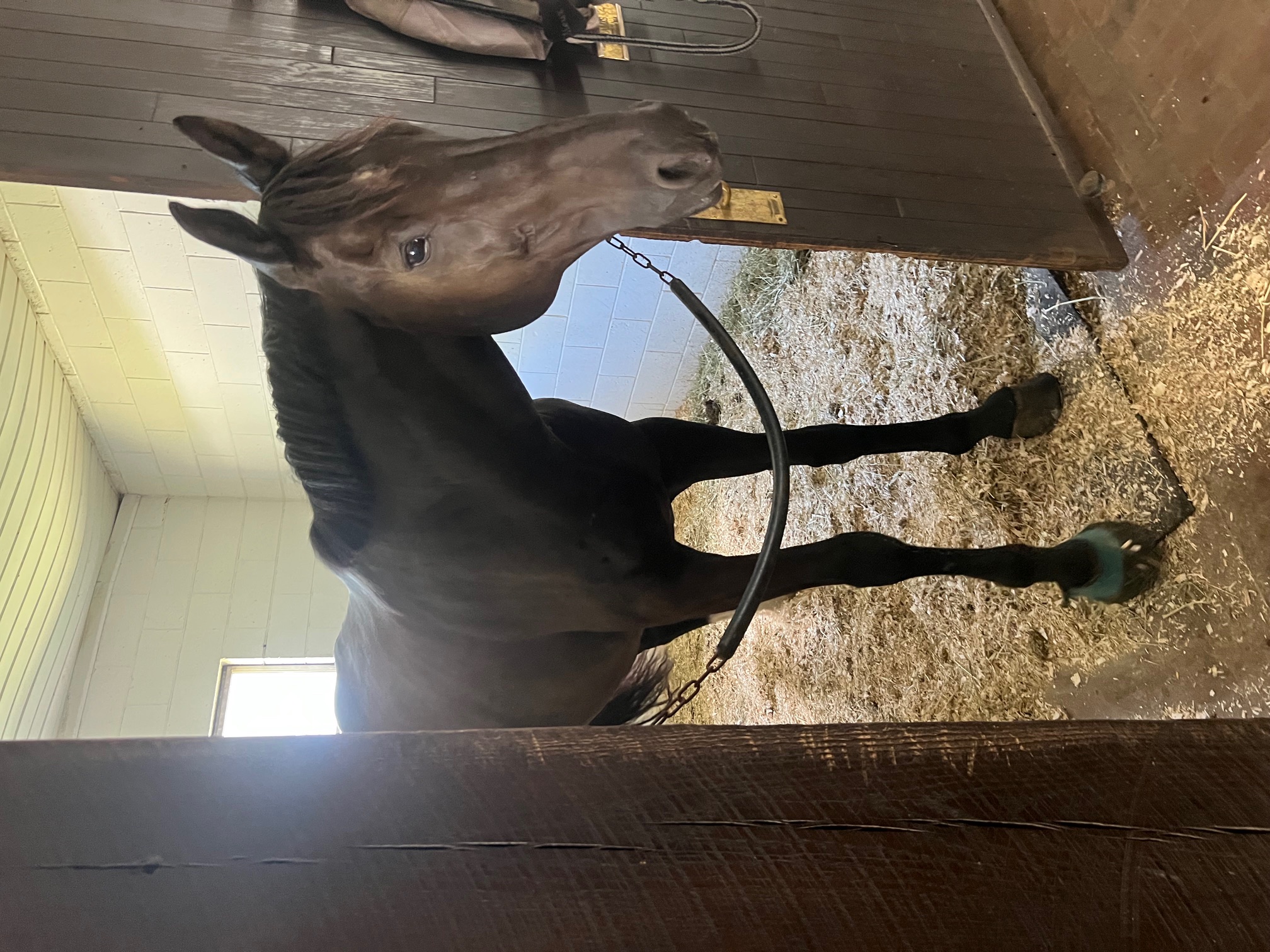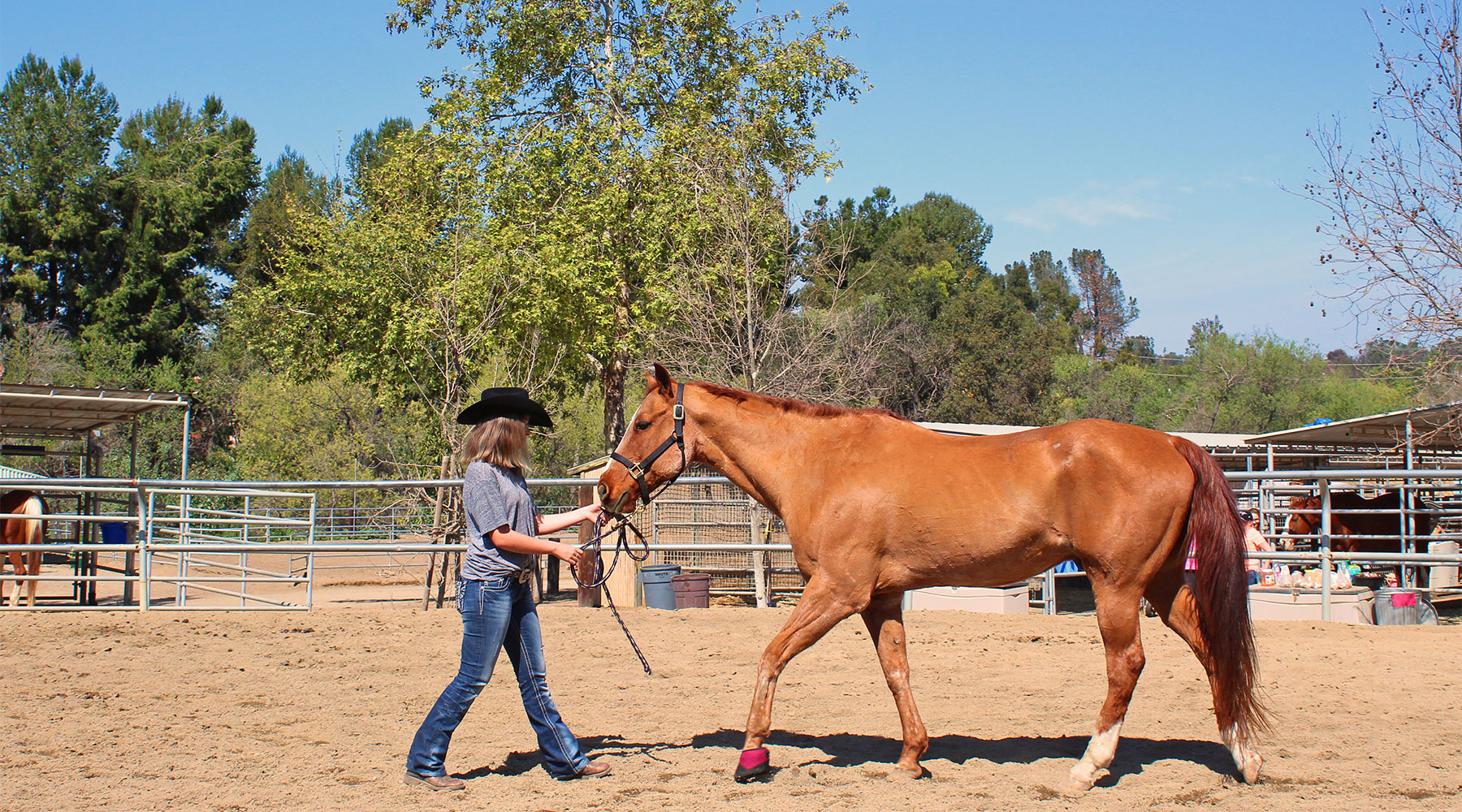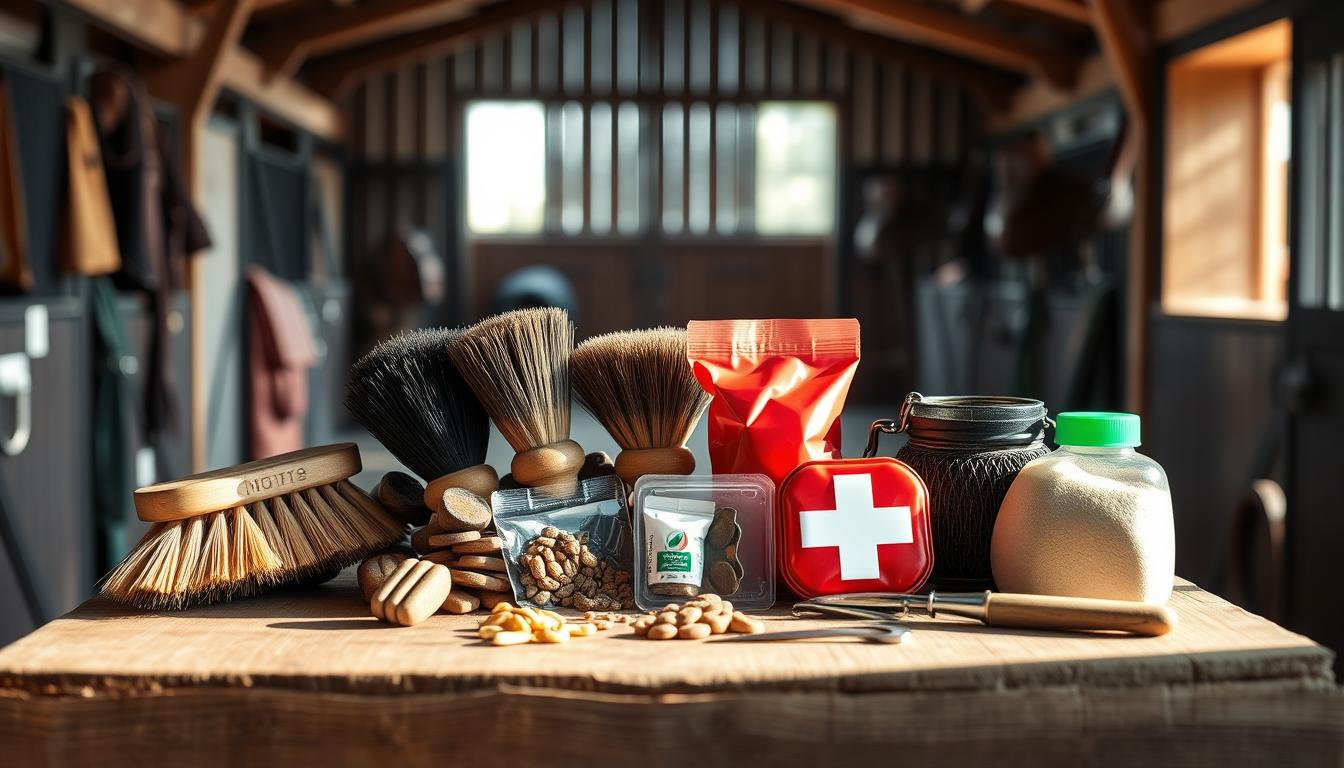Healthy Hooves & Beyond
Monster Featured Friends

Aramis says thank you for the boot.
It fits like a glove, he loves wearing it and the shoe boil is looking under control.
We appreciate all your help Kim.
- Lidiya and Aramis
Tewksbury NJ
Understanding and Managing Shoe Boils in Horses: Effective Treatment Strategies
Shoe boils, also known as olecranon bursitis, are a common yet often overlooked ailment in horses. These swellings occur at the point of the elbow and can cause discomfort, potentially leading to more serious issues if left untreated. Recognizing shoe boil symptoms and implementing effective shoe boil treatments are crucial steps in maintaining your horse's health and performance.
What Are Shoe Boils?
A shoe boil is a soft, fluid-filled swelling that develops at the horse's elbow, typically resulting from repeated trauma or pressure when the horse lies down. Factors such as inadequate bedding or the horse's shoe contacting the elbow during rest can contribute to this condition. While often not causing lameness, untreated shoe boils can become infected, leading to pain and more severe complications.
Recognizing Shoe Boil Symptoms
Early detection of shoe boil symptoms is essential for effective treatment. Common signs include:
-
Swelling at the Elbow: Noticeable soft or firm swelling at the point of the elbow.
-
Heat and Sensitivity: The affected area may feel warm and be sensitive to touch.
-
Fluid Accumulation: A palpable fluid-filled sac under the skin.
If you observe these symptoms, it's important to consult a veterinarian for an accurate diagnosis and to discuss appropriate shoe boil treatments.

Effective Shoe Boil Solutions
Addressing shoe boils promptly can prevent further complications. Here are some effective shoe boil solutions:
-
Protective Gear: Using specialized equipment like the Monster Shoe Boil Bracelet can cushion the elbow, reducing friction and pressure that contribute to shoe boils.
-
Proper Bedding: Ensuring your horse's stall has adequate, soft bedding can minimize trauma to the elbow area when lying down.
-
Hoof Care: Regular trimming and appropriate shoeing can prevent the horse's hoof or shoe from contacting the elbow during rest.
-
Medical Intervention: In cases where infection is present, veterinary shoe boil treatment may involve draining the bursa and administering antibiotics.
Preventive Measures and Management
Preventing shoe boils is preferable to treating them. Implementing the following strategies can help:
-
Regular Inspections: Frequently check your horse's elbows for early signs of swelling or irritation.
-
Environment Optimization: Maintain clean, well-bedded stalls to provide a comfortable resting area.
-
Use of Protective Devices: Equip your horse with products like the Monster Shoe Boil Bracelet to offer continuous protection against elbow trauma.
Conclusion
Shoe boils, while common, can be effectively managed and prevented with proper care and the right tools. By staying vigilant for shoe boil symptoms and implementing proven shoe boil treatments, you can ensure your horse remains healthy and comfortable. Investing in quality products like the Monster Shoe Boil Bracelet is a proactive step toward optimal equine health.
For more information on shoe boil solutions and other equine health products, visit Monster Horse Products.
In our how-to guide, discover the 7 keys to basic horse care, including shoe boil prevention and tips for a healthy horse.
Keeping your equine companion healthy starts with understanding the essentials of proper care. From preventing common issues to recognizing early signs of concern, proactive measures can make a significant difference. One of the most overlooked areas is repetitive trauma, which can lead to inflammation and discomfort in sensitive areas like the elbow.
Our guide leverages expert advice from veterinarians and farriers to help you address these challenges. By focusing on preventive strategies, you can avoid complications like lameness and tissue injury. Early treatment is key to ensuring your animal remains comfortable and active.
We’ll walk you through symptom recognition, causation, and long-term management. These insights are based on clinical facts and real-life examples, providing you with actionable steps to maintain optimal health. Let’s dive into the seven keys to keeping your equine partner in top shape.
Key Takeaways
- Preventive measures can reduce the risk of inflammation and lameness.
- Repetitive trauma in sensitive areas requires early attention.
- Expert advice from veterinarians ensures effective care strategies.
- Recognizing symptoms early helps in timely treatment.
- Proper management prevents long-term tissue injury.
Shoe Boil, Horse Care: An Essential Overview
Addressing repetitive trauma early can save your equine partner from discomfort. One common issue is the development of shoe boils, which occur when the elbow area repeatedly contacts the heel of the shoe. This constant pressure can lead to inflammation and swelling, causing pain and potential lameness.
According to Ken Keckler DVM, this condition often arises when the animal lies down, exposing the elbow to trauma. Over time, fluid pockets may form beneath the skin, resulting in seromas or hematomas. Understanding these differences is crucial for effective treatment and prevention.
Preventive measures, such as modifying shoe design and using protective padding, can significantly reduce the risk. These steps help alleviate pressure on the elbow, minimizing the chance of tissue injury. Early intervention is key to ensuring your equine companion remains healthy and active.
By recognizing the signs of inflammation and addressing them promptly, you can prevent long-term complications. Consulting a veterinarian for expert advice ensures you’re taking the right steps to protect your animal’s well-being.

Recognizing the Signs and Symptoms
Spotting early signs of discomfort in your equine friend is crucial for their well-being. Visual cues and behavioral changes can provide valuable insights into their health. By staying observant, you can address issues before they escalate.
Identifying Visual Cues and Abnormal Swelling
One of the first signs to look for is swelling near the elbow. This area may appear puffy or develop a soft, fluid-filled sac. Changes in the skin, such as redness or warmth, can also indicate inflammation.
If left untreated, the swelling can harden, leading to more severe tissue damage. Regular checks during grooming or handling can help you catch these symptoms early.
Observing Behavioral and Movement Changes
Behavioral changes are another key indicator. Your animal may show reluctance to move or exhibit an unusual gait. This could be a sign of pain or pressure in the affected area.
Lameness, even if mild, should not be ignored. It often points to underlying trauma or discomfort. Consulting a veterinarian at this stage ensures timely treatment and prevents long-term complications.
About 75% of horses get horse shoe boils at some point. This is a common issue that can hurt and bother horses. It's important to know how to stop and treat these boils. Knowing about horse shoe boils helps keep horses healthy. This article will guide you through what causes them, their signs, treatment, and how to prevent them. It's all about keeping your horse comfortable and healthy.
Key Takeaways
Horse shoe boils are a common problem that affects 75% of horses.
Understanding the causes and symptoms of horse shoe boils is crucial for effective treatment.
Horse shoe boil prevention is key to promoting overall horse health.
Learning how to treat shoe boils in horses can help alleviate pain and discomfort.
Regular monitoring and proper care can help prevent horse shoe boils.
Effective treatment options are available for horse shoe boils, including medical and surgical interventions.
Understanding Horse Shoe Boils
Horse shoe boils are a common problem in the equine world.
A horse shoe boil, also known as olecranon bursitis or capped elbow, is a swelling on the elbow that's usually caused by trauma to the joint.
Causes
• Repeated pressure on the elbow, often when lying down
• The heel of a horseshoe rubbing the elbow
• Long-heeled horseshoes
• Shallow bedding
• Hard surfaces
Symptoms
• A firm, movable swelling on the point of the elbow
• Heat and tenderness
• Pain to the touch
Treatment
• Protect the elbow from the foot
• Increase bedding in the stall
• Use a shoe boil boot
• Drain the fluid and inject steroids into the bursa
• Apply topicals, such as DMSO, to reduce inflammation
If not treated, they can cause serious health issues. It's key to know their causes and symptoms.
Keeping your horse healthy is also crucial. This includes regular grooming, proper hoof care, and a balanced diet. By focusing on horse health, owners can lower the risk of horse shoe boils. This ensures their horses stay happy and healthy.
Identifying the Signs and Symptoms
It's important to spot horse shoe boils symptoms early. This helps in treating them quickly and avoiding bigger problems. Look out for swelling, redness, and pain in your horse's skin.
Watching your horse closely can help you catch these signs early. This way, you can act fast to help them feel better.
The Multipurpose Barn Bootie by Monster Horse Products is ideal for preventing and treating these boils. They cover the hoof so it does not irritate the elbow when your horse is lying down
Horse wound care boots are great for preventing and treating these boils. They protect and support the area, helping your horse heal. Keeping up with your horse's health can also stop boils from happening.
Knowing the signs of horse shoe boils is key to caring for your horse. Spotting them early and acting fast can prevent bigger issues. Regular vet visits and using the right boots are important for your horse's health.

Treatment Options and Recovery Timeline
Dealing with horse shoe boils requires a detailed plan to keep the horse healthy. The main aim is to lessen pain, reduce swelling, and stop more problems. This involves using medicine, surgery, and careful recovery steps.
Doctors might use antibiotics and anti-inflammatory drugs to help. Sometimes, surgery is needed to drain the boil and help it heal. It's important to talk to a vet to find the right treatment.
Recovery Management Strategies
Managing recovery is key in treating horse shoe boils. It means creating a safe space for the horse to heal and avoiding more issues. Using horse transport boots can also help by making travel less stressful.
Post-Treatment Care
After treatment, it's vital to watch the horse closely and adjust the care if needed. This might include regular vet visits and ongoing care to avoid future problems. A thorough and proactive approach to treatment ensures the best health for the horse.
Prevention Strategies and Best Practices
To prevent horse shoe boils, it's important to take care and manage things right. Keeping the living area clean and dry is key. Use good bedding like straw or wood shavings and make sure the stable has good air flow.
Bedding Solutions
Choosing the right bedding is crucial. It should soak up moisture, stay dry, and not have mold or bacteria. Changing the bedding often helps keep infections away and keeps horses healthy.
Stable Environment Modifications
Changing the stable environment helps too. Make sure it's well-ventilated, has enough light, and is always clean and dry. Good stable management, like regular cleaning and disinfecting, keeps the environment healthy for horses.
Protective Equipment Selection
Choosing the right protective gear is key to preventing horse shoe boils. Horse transport boots and leg protection wraps are essential. They help keep your horse safe from injury and infection.
Finding the right equipment can be tough with so many options. But, think about what your horse needs. Transport boots protect legs during rides. Leg wraps offer extra support and safety.
Hoof boots are also important for preventing boils. They give extra support and protection to the hooves. The right mix of equipment keeps your horse healthy and happy.
Choosing the right gear means thinking about your horse's needs. This ensures your horse gets the best protection and care. It helps prevent boils and keeps your horse healthy.
Role of Antimicrobial Horse Leg Wraps
Antimicrobial horse leg wraps are key to keeping horses healthy. They reduce the chance of infections. These wraps have agents that kill bacteria and other harmful organisms. Using these wraps helps prevent infections like MRSA. MRSA is a big threat to horse health. Antimicrobial wraps help keep horses safe and prevent horse shoe boils. These wraps also protect against other infections. They help keep horses healthy and prevent horse shoe boils. Antimicrobial horse leg wraps are vital for horse health and infection prevention.
Managing Secondary Complications
Managing secondary complications from horse shoe boils is key to keeping your horse healthy. It's important to prevent infections and follow proper wound care. This helps avoid further health issues and promotes healing.
Horse health is closely tied to how you manage horse shoe boils. If not treated right, these boils can cause infections and abscesses. Using horse wound care boots can help protect the area and aid in healing. Regular care and monitoring are crucial to prevent complications and keep your horse well.
To manage secondary complications effectively, you need a detailed plan. This includes preventing infections, following wound care steps, and keeping a close eye on your horse's health. By being proactive and informed, you can prevent complications and ensure your horse stays healthy. Using specialized boots, like horse wound care boots, is also important to protect the area and support healing.
When to Seek Veterinary Care
It's important to know the signs of horse shoe boils to treat them quickly. If you think your horse has a shoe boil, get veterinary care fast. A vet can diagnose and suggest treatment, like using wraps for joint protection. Watching your horse's health closely is key. Knowing about shoe boils and their causes helps prevent them. Early action can greatly improve your horse's health and recovery. Good horse health practices are also crucial. Proper care can prevent shoe boils. By being proactive and seeking vet help when needed, your horse can stay happy and healthy.
Long-term Management Strategies
Keeping your horse healthy for the long term is key when dealing with shoe boils. Use ongoing prevention methods like a clean living space. Regular vet visits are also important to catch issues early.
Ongoing Prevention Methods
Keeping your horse's area clean and dry is crucial. Check and change bedding often to avoid pressure on their hocks. Also, use horse hoof protection boots to protect their legs from injury.
Regular Monitoring Guidelines
Regular vet visits are essential for your horse's health. They can spot shoe boils or hoof issues early. Your vet will tell you how often to visit and give advice on prevention.
FAQ
What are horse shoe boils?
Horse shoe boils, also known as capped elbows, are a skin infection. They happen when bacteria get into the skin through cuts or wounds. These infections can be painful and may lead to serious health issues if not treated.
Where do horse shoe boils commonly develop?
They often appear on the elbow but can also show up on the hock or knee.
How do horse shoe boils impact a horse's health?
These boils can seriously affect a horse's health. Untreated, they can cause more severe infections like cellulitis or abscesses. These can be life-threatening. They also cause pain and discomfort, making it hard for the horse to move and perform.
What are the common causes of horse shoe boils?
Several things can cause horse shoe boils. Improper bedding, trauma, and poor stable management are common culprits. Bad bedding can irritate the skin, while injuries can lead to infections. Poor stable conditions also help bacteria grow.
When should a veterinarian be consulted for horse shoe boils?
Seeking vet care is crucial for timely treatment and prevention of complications. If you suspect a shoe boil, get veterinary help quickly. A vet can diagnose and recommend treatment.
What long-term management strategies are important for preventing horse shoe boils?
Long-term strategies are vital. Keeping the environment clean and using proper bedding are essential. Regular vet check-ups help catch health issues early.
